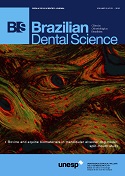Association of chlorhexidine and high fluoride dentifrice on Streptococcus mutans viability using an in vitro biofilm model
DOI:
https://doi.org/10.14295/bds.2016.v19i3.1258Resumo
Objective. This in vitro study investigated the effect of Fluoride (F), Chlorhexidine (CHX), and their association on the viability of Streptococcus mutans using a biofilm model. Materials and Methods. Biofilms were anaerobically grown on glass slides that were vertically suspended in 24-well plates for 5 days. After 48 h of initial growth, biofilms were treated for the next 72 h, 2x/day with CHX at 0.12% and 2%, F as NaF at 0.08% and 0.4% and their association. Results. CHX treatment decreased the bacteria counts either alone or in association with both F concentrations, when compared with control group and the F treatments alone (p<0.05). Conclusion. No addition effect was observed when CHX and F were used in combination, when compared with CHX used alone.
Downloads
Downloads
Publicado
Como Citar
Edição
Seção
Licença
TRANSFERÊNCIA DE DIREITOS AUTORAIS E DECLARAÇÃO DE RESPONSABILIDADE
Toda a propriedade de direitos autorais do artigo "____________________________________________________________________" é transferido do autor(es) para a CIÊNCIA ODONTOLÓGICA BRASILEIRA, no caso do trabalho ser publicado. O artigo não foi publicado em outro lugar e não foi submetido simultaneamente para publicação em outra revista.
Vimos por meio deste, atestar que trabalho é original e não apresenta dados manipulados, fraude ou plágio. Fizemos contribuição científica significativa para o estudo e estamos cientes dos dados apresentados e de acordo com a versão final do artigo. Assumimos total responsabilidade pelos aspectos éticos do estudo.
Este texto deve ser impresso e assinado por todos os autores. A versão digitalizada deverá ser apresentada como arquivo suplementar durante o processo de submissão.




























